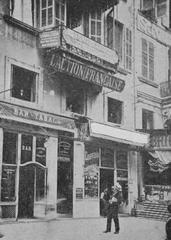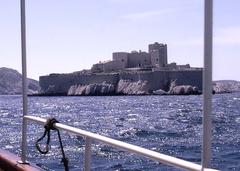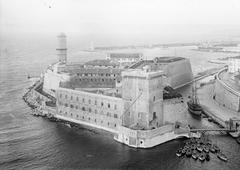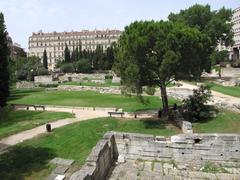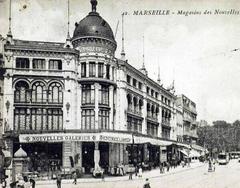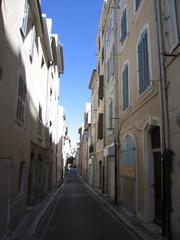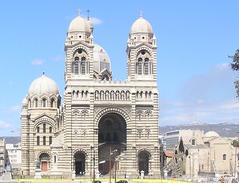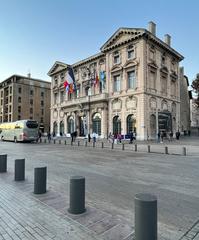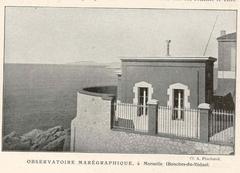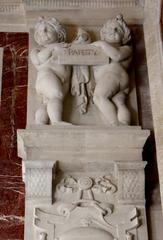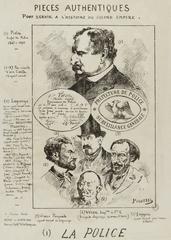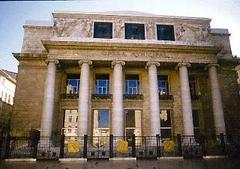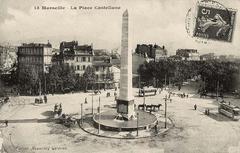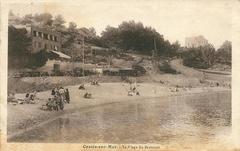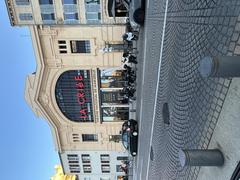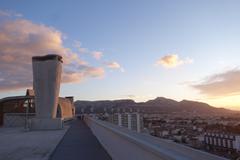Palais de Justice Marseille: Visiting Hours, Tickets, and Historical Site Guide
Date: 04/07/2025
Introduction
The Palais de Justice in Marseille stands as a monumental symbol of the city’s legal heritage, architectural grandeur, and civic pride. Completed in 1862 under architect Auguste Martin, this neoclassical courthouse replaced the older Hôtel Daviel to accommodate Marseille’s burgeoning judicial needs during a period of rapid growth. Its strategic location at Place Montyon (now Square Pierre Michel) not only emphasizes its significance in the city’s urban landscape but also anchors it within Marseille’s vibrant cultural fabric (tourisme-marseille.com; marseille13.fr).
Beyond its ongoing role in the legal system, the Palais de Justice captivates visitors with its grand Ionic-columned façade, allegorical sculptures, and an interior highlighted by red marble columns and portraits of legendary lawmakers. These features collectively reflect the virtues and authority of the French judicial tradition, making the building a cultural landmark in Marseille (marseille-tourisme.com; Wikipedia).
This comprehensive guide covers the history, architecture, visiting hours, ticket policies, accessibility, security protocols, and nearby attractions—offering everything you need to plan a memorable visit to one of Marseille’s most important historical sites.
Historical Background
Origins and Early Judicial Architecture
The story of Marseille’s Palais de Justice begins in the 18th century, when the original Hôtel Daviel courthouse was constructed between 1743 and 1747 at Place Daviel. With Marseille’s expansion and increased judicial activity in the 19th century, the Hôtel Daviel quickly proved inadequate (tourisme-marseille.com).
In 1839, it was decided to relocate the courthouse to Place Montyon, a site formerly occupied by the Arsenal des galères, reinforcing the area’s historic ties to civic and military life (marseille13.fr).
Construction and Inauguration
Approved in 1856, the new courthouse was designed by Auguste Martin in the neoclassical style popular during the Second Empire. The building, measuring 57 by 54 meters, was inaugurated on November 4, 1862, in a ceremony attended by the city’s leading civic and religious figures (marseille13.fr).
Architectural Significance
Exterior Features
The Palais de Justice’s façade is dominated by a sweeping staircase of 25 steps leading to a peristyle of six Ionic columns. The triangular pediment above, sculpted by Eugène Guillaume, features allegorical figures: Justice at the center, with Force, Prudence, Crime, and Innocence completing the tableau. Additional bas-reliefs by Guillaume represent repressive and protective justice (tourisme-marseille.com).
The rear façade on Rue Grignan is more austere, with Napoleonic symbols and lions by Émile Aldebert. Statues by Joseph Marius Ramus (Force and Prudence) and Pierre Travaux (Firmness, Moderation, Vigilance, Wisdom) further adorn the exterior.
Interior Highlights
Inside, the “salle des pas perdus” is a grand, square hall supported by 16 red marble columns from Languedoc. The coffered ceiling displays portraits of major lawmakers—Solon, Justinian, Charlemagne, Napoleon I—each surrounded by collaborators from their era. Artistic details throughout, including sculptures of virtues such as Equity, Reason, Law, Liberty, Authority, Truth, and Eloquence, emphasize the building’s didactic purpose (marseille.fr).
Judicial and Civic Role
Since its inauguration, the Palais de Justice has been at the heart of Marseille’s legal system, hosting both routine proceedings and high-profile cases such as the notorious “Bande des Trois” trial linked to the French Connection (marseille13.fr). Today, it houses key judicial chambers, archives, and evidence rooms, maintaining its central role in city governance.
The courthouse’s prominent location and architectural gravitas make it a focal point for civic engagement, demonstrations, and public commemorations, further reinforcing its symbolic status (tourisme-marseille.com).
Visiting Information
Location and Getting There
- Address: 6 Place Montyon, 13006 Marseille
- Public Transport: Metro line 1 (Estrangin-Préfecture stop), multiple bus lines (including Bus 81)
- Parking: Limited underground parking available beneath the esplanade (marseille.fr)
Visiting Hours
- Weekdays: Monday to Friday, 9:00 am to 4:30 pm
- Closed: Weekends and public holidays
- Special Events: Interior access may be available during European Heritage Days (annually in September) and other cultural events (marseille-tourisme.com)
Entry and Tickets
- Admission: Free of charge
- Security: All visitors must pass through security checks; bring valid identification (Sainte-Chapelle.co)
- Guided Tours: Not regularly available; check official sites for special event tours
Accessibility
- Mobility: Ramps and elevators throughout the building ensure accessibility for visitors with reduced mobility
- Assistance: Contact the courthouse in advance if special accommodations are needed
Visitor Etiquette
- Silence required; respect ongoing judicial proceedings
- Photography and videography are strictly prohibited inside the building
- Dress modestly and behave respectfully at all times
Modernization and Restoration
Between 2013 and 2015, the Palais de Justice underwent a major €15 million restoration to address structural issues caused by subsidence and to modernize its facilities. This project included cleaning stone façades, updating courtrooms and security systems, and enhancing accessibility, ensuring the building’s continued use as both a courthouse and a heritage site (tourisme-marseille.com).
Nearby Attractions
The Palais de Justice’s central location makes it an excellent starting point for exploring Marseille’s rich historical and cultural landscape:
- Vieux-Port (Old Port): The iconic harbor area bustling with activity
- Le Panier: The city’s oldest district, famed for its winding streets and vibrant murals
- Hôtel Daviel: The original 18th-century courthouse, now serving as municipal offices
- Cours Julien: Artistic neighborhood with street art and trendy cafés
- MuCEM: Museum of European and Mediterranean Civilisations
- Cathedral of La Major: Imposing 19th-century Catholic cathedral (The Tourist Checklist; Voyage Tips)
Essential Visitor Tips
- Plan ahead: Check opening hours on the official city website before your visit
- Arrive early: Allow extra time for security, especially during busy periods
- Respect protocols: Silence and no photography inside; follow all posted rules
- Best times: Visit on weekday mornings during spring or fall for a quieter experience
- Combine visits: Explore nearby attractions for a fuller cultural itinerary
Frequently Asked Questions (FAQ)
Q: What are the Palais de Justice Marseille visiting hours?
A: Open Monday to Friday, 9:00 am to 4:30 pm; closed weekends and public holidays.
Q: Is there an entry fee?
A: No, entry is free, but security screening is required.
Q: Are guided tours available?
A: Regular guided tours are not offered; look for special events such as European Heritage Days.
Q: Is the building accessible to people with disabilities?
A: Yes, with ramps and elevators throughout.
Q: Is photography allowed inside?
A: No, photography and videography are strictly prohibited in the building.
Q: What are recommended nearby attractions?
A: Vieux-Port, Le Panier, Hôtel Daviel, Cours Julien, MuCEM, and the Cathedral of La Major.
Recent and Future Developments
Proposals are underway to expand the building’s civic use, including possibly relocating Marseille’s metropolitan authority to the Palais de Justice as the court’s primary functions move to a new judicial complex by 2031 (tourisme-marseille.com). This reflects the courthouse’s enduring role as a symbol of civic identity and urban renewal in Marseille.
Conclusion
The Palais de Justice Marseille is far more than a courthouse: it is a living monument to justice, culture, and the ongoing story of Marseille. Its neoclassical design, historical significance, and central role in city life make it a must-see for anyone interested in French history, architecture, or civic life. With free public entry during business hours and rare opportunities for guided tours during special events, the Palais de Justice offers an enriching window into Marseille’s past and present.
For the latest visiting information, event announcements, and travel tips, consult the official Marseille city website and Wikipedia.
Enhance your experience with the Audiala app for audio guides and local insights, and follow us on social media for updates on Marseille’s historical treasures.
Official Sources
- Palais de Justice Marseille, History, Architecture, and Visitor Guide – tourisme-marseille.com
- Palais de Justice Marseille – marseille13.fr
- Visiting the Palais de Justice in Marseille – Marseille Tourism
- Palais de Justice de Marseille – Wikipedia
- Palais de Justice Marseille – Marseille.fr
- Sainte-Chapelle.co: Palais de Justice Practical Information
- World City Trail: Pavillon Daviel in Marseille
- The Tourist Checklist: Things to Do in Marseille
- Voyage Tips: Things to Do in Marseille
Enhance your Marseille exploration by downloading the Audiala app for audio guides and insider tips. Follow us on social media for more updates and related travel posts about Marseille’s historical sites and attractions.
